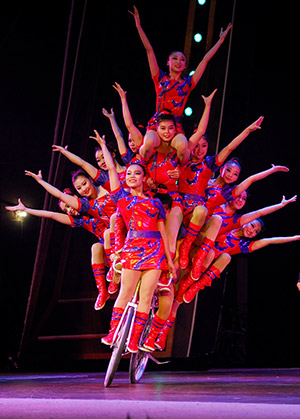
Chinese acrobats again take the center stage to perform feats that will leave you breathless and utterly amazed.
Historical records, carvings, and mural paintings in tombs and grottoes date the origins of Chinese acrobatics more than two thousand years ago. They developed mostly during the Qin and Han Dynasties (221 B.C.-230 A.D.) and reached a remarkable level of quality and refinement during the Western Han Dynasty.
Many of the Chinese acrobatic acts have evolved from the Chinese people’s everyday life, notably among peasants. They practiced this new art form with items they found around the house and farm - cups, saucers, plates, tables, chairs, pitchforks, and many other common items. It has grown into a rich and eclectic repertory including tumbling, balancing, plate spinning, pole dancing, rope spinning, hoop diving, and more.
Chinese acrobats are so popular with the Center for the Arts audience, that multiple performances are scheduled. This season the Cirque Mei troop from the Hebei Province bring their unique blend of strength, agility, and artistry. Their repertoire includes acrobatics, contortion tricks, juggling, hoop diving, cycling feats and the classic lion dance. Bring the whole family on October 19. You will leave asking “How did they do that?”
